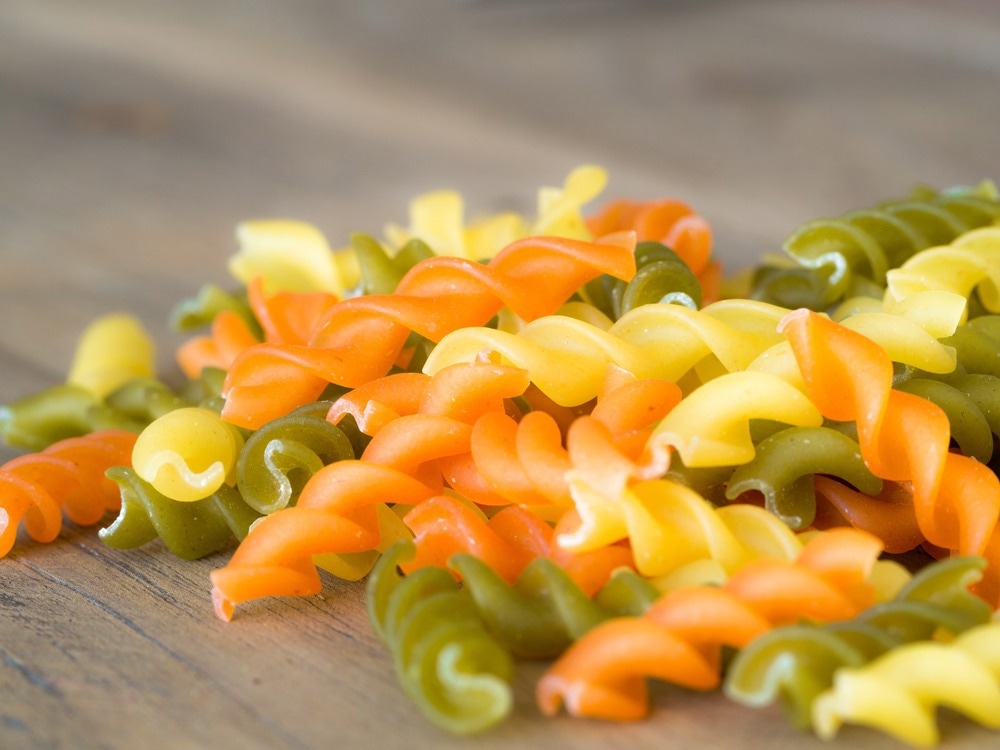In a recent study published in Foods, researchers used Mediterranean black chickpea flour in the form of a semi-liquid dough fermented with the bacteria Lactiplantibacillus plantarum to develop fortified semolina pasta with improved nutritional quality.

Background
Pasta is one of the most widely consumed foods and a good carbohydrate and protein source. The estimate by the International Pasta Organization reported that the annual production of pasta for 2018 was 14.5 million tons, and the annual growth rate was expected to be 2.7% until 2025. With variable fiber levels and very low amounts of fat, pasta is a good candidate for nutrient fortification in the current trend toward healthier food choices.
Various studies have explored the fortification of pasta with different cereals, pseudocereals, legumes, oregano, fish, carrot leaf meal, brewers spent grain, maize, and grape marc. Using different flours not only presents a healthier alternative but is also seen as a positive step towards supporting the environment and local economy. Legumes are a better protein source than wheat and are also rich in dietary fibers, minerals, and vitamins.
However, they also contain anti-nutritional compounds such as tannins, α-galactosides, phytic acid, saponins, and trypsin inhibitors. Methods such as enzyme treatment, germination, roasting, boiling, and steaming have been used to decrease the levels of these compounds. Tailored fermentation using specific lactic acid bacteria is the most optimal method for reducing the anti-nutritional compounds while fully utilizing the nutritional potential of the legumes.
About the study
In the present study, the researchers fermented black chickpea flour by inoculating the dough with L. plantarum and incubating it for 24 hours at 30 °C. Before inoculation, L. plantarum was cultivated and monitored using optical density measurements to ensure it reached the exponential growth stage. As controls, non-inoculated and non-incubated samples of dough were used.
The dough samples were characterized through microbial analyses by assessing colony morphologies of yeast and molds and a determination of total Enterobacteriaceae. Biochemical analyses included measurements of pH, total free amino acids, and acetic and lactic acids. Sequential enzyme treatments were also used to assess the in vitro protein digestibility. Three different methods were also used to determine the antioxidant activity of the dough samples.
Additionally, the free and bound types of phenolic compounds were extracted, identified, and quantified. The concentrations of antinutritional factors such as raffinose, condensed tannins, trypsin inhibitors, and saponins were also measured. The La Parmigiana pilot pasta plant made experimental pasta using the fermented and control dough samples.
The pasta was then characterized based on cooking time, hydration test, water absorption, and cooking loss. The protein, moisture, dietary fiber, ash, and fat contents were also evaluated. Furthermore, the starch and protein digestibility were assessed, and the predicted glycemic index was calculated. The pasta samples were also subjected to texture, color, and sensory analyses.
Results
The results reported that the fermentation process using L. plantarum released 20% of the bound phenolic compounds in the black chickpea flour dough. The fermentation process also converted free phenolic compounds into more active forms, such as phloretic and dihydrocaffeic acids, which have high antiradical effects and antioxidant properties and have shown ex vivo protective effects on endothelial cells against oxidative stress.
While the fermented dough samples had significantly lower levels of anti-nutritional factors such as saponins, trypsin inhibitors, raffinose, and condensed tannins, the concentrations of free amino acids and resistant starch were considerably higher in the fermented dough samples as compared to the control samples. Pasta fortified with fermented black chickpea dough had higher protein digestibility in vitro and a lower hydrolysis rate for starch than the traditional pasta made from semolina.
Furthermore, the organoleptic profile of cooked fortified pasta based on the scavenging activity against 2,2-diphenyl-1-picrylhydrazyl (DPPH) and 2,2'-azino-di-[3-ethylbenzthiazoline sulphonate])(ABTS) was well appreciated. The fermentation process also resulted in the fortified pasta having a more subtle flavor than pasta containing unfermented chickpea dough.
Conclusions
Overall, the results indicated that fermentation with L. plantarum effectively reduced the anti-nutritional factors and increased black chickpea flour's nutritional potential. The use of fermented black chickpea flour dough in fortifying pasta resulted in an appreciable flavor profile and enhanced nutritional content of the pasta. Fortification of pasta using fermented chickpea dough is a promising method to enhance the nutritional content while promoting and sustaining local cultivars.
https://news.google.com/rss/articles/CBMiwQFodHRwczovL3d3dy5uZXdzLW1lZGljYWwubmV0L25ld3MvMjAyMzAyMjQvU3R1ZHktc3VnZ2VzdHMtZmVybWVudGF0aW9uLWFzLWEtc3VzdGFpbmFibGUtYW5kLWVhc2lseS1hcHBsaWNhYmxlLWJpb3RlY2hub2xvZ3ktdG8tb3ZlcmNvbWUtdGhlLWxlZ3VtZS1mbG91ci10ZWNobm9sb2dpY2FsLWFuZC1zZW5zb3J5LWRyYXdiYWNrcy5hc3B40gHFAWh0dHBzOi8vd3d3Lm5ld3MtbWVkaWNhbC5uZXQvYW1wL25ld3MvMjAyMzAyMjQvU3R1ZHktc3VnZ2VzdHMtZmVybWVudGF0aW9uLWFzLWEtc3VzdGFpbmFibGUtYW5kLWVhc2lseS1hcHBsaWNhYmxlLWJpb3RlY2hub2xvZ3ktdG8tb3ZlcmNvbWUtdGhlLWxlZ3VtZS1mbG91ci10ZWNobm9sb2dpY2FsLWFuZC1zZW5zb3J5LWRyYXdiYWNrcy5hc3B4?oc=5
2023-02-24 11:31:00Z
CBMiwQFodHRwczovL3d3dy5uZXdzLW1lZGljYWwubmV0L25ld3MvMjAyMzAyMjQvU3R1ZHktc3VnZ2VzdHMtZmVybWVudGF0aW9uLWFzLWEtc3VzdGFpbmFibGUtYW5kLWVhc2lseS1hcHBsaWNhYmxlLWJpb3RlY2hub2xvZ3ktdG8tb3ZlcmNvbWUtdGhlLWxlZ3VtZS1mbG91ci10ZWNobm9sb2dpY2FsLWFuZC1zZW5zb3J5LWRyYXdiYWNrcy5hc3B40gHFAWh0dHBzOi8vd3d3Lm5ld3MtbWVkaWNhbC5uZXQvYW1wL25ld3MvMjAyMzAyMjQvU3R1ZHktc3VnZ2VzdHMtZmVybWVudGF0aW9uLWFzLWEtc3VzdGFpbmFibGUtYW5kLWVhc2lseS1hcHBsaWNhYmxlLWJpb3RlY2hub2xvZ3ktdG8tb3ZlcmNvbWUtdGhlLWxlZ3VtZS1mbG91ci10ZWNobm9sb2dpY2FsLWFuZC1zZW5zb3J5LWRyYXdiYWNrcy5hc3B4
Bagikan Berita Ini














0 Response to "Study suggests fermentation as a sustainable and easily applicable biotechnology to overcome the legume flour technological and sensory drawbacks - News-Medical.Net"
Post a Comment